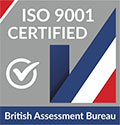Safety heavily influences the strength of your workforce and is always a top priority for every project. One way to improve the safety of your workforce is through employee resilience. Employee resilience can add to your workforce safety, helping to increase productivity, reduce sick days and injuries, and help employees feel healthier overall.
What is employee resilience?
The World Health Organization considers health “a state of complete physical, mental, and social well-being, and not merely the absence of disease or infirmity.†However, employee resilience is the ability to recover from setbacks, adapt well to change, and keep going in the face of adversity, according to the Harvard Business Review.
The traditional model of employee resilience depends on individuals to balance the pressures of home life and work stress themselves and leads employees to only cope with stress. Tim Marsh of RyderMarsh and Plymouth University in the U.K. proposed a “thriving†employee workforce model that differs from the traditional “coping†or “resilience†models.  According to Marsh’s theory, a “thriving†workforce happens when workplaces assume a large part of the responsibility to create a positive culture in which individuals can thrive. Employees’ home life and work culture are treated as one and workplaces take into account the personal habits of energy/alertness creation and resilience, home life, and work environment.
Why implement an employee resilience program?
Comprehensive resilience programs include improving physical health, methods for dealing with challenging situations and colleagues, remaining calm under pressure, coping with work-related stress, and accurately identifying the causes of work-related problems. Workplaces can use health and wellness programs, worker assistance programs, and mental health first aid to promote this employee resilience.
In a 2017 poll conducted by researchers from the American Heart Association, more than 75 percent of employees surveyed said they consider resiliency programs at least somewhat valuable. However, only 25 percent said their employers offer them. Of the workers whose employers offer a resilience program, 80 percent reported using the programs, and 73 percent said their health improved as a result.
There are many benefits of implementing an employee resilience program. Resilient employees:
- Have better productivity
- Use fewer sick days
- Perform even when they aren’t feeling 100 percent physically healthy
- Fight off illness more easily
- Incur less injuries
- Are simply physically healthier overall
What should be included in an employee resilience program?
Having medical services on-site can provide significant returns. From taking a proactive approach to medical care through health promotion programs, to treating injuries on-site when they occur, medical services can promote employee well-being.
By also using integrated health and safety, employers can build a true culture of health and safety with not just a robust safety program, but also a program that focuses on worker health and well-being.
Integrated health and safety is defined as “the blending of health and safety programs along a continuum of organizational, personal, and occupational activities to enhance overall worker well-being and prevent work-related injuries and illnesses.â€
To increase the mental and social well-being of your workforce, it is important to show that employees are valued. Employees feel valued when they have access to health and wellness programs, have a culture and policies of team-building, and are given formal and informal recognition for their contributions.
Not only do employees see numerous health benefits from focusing on a resilient workforce, employees think higher of employers who encourage resilience programs.
How does Remote Medical International help with employee resilience?
At Remote Medical International, we strive to help employees make good decisions about their overall health and fully understand the importance of employee health and well-being.
Our on-site staff provide health education through health talks at the beginning of the work day, and assess any medical issues such as obesity, high blood pressure, diabetes, smoking, and alcohol overuse. Our staff are proactive with their patients and even bring water to workers on their downtime. When workers start making healthy adjustments to their daily habits, they lead overall healthier lives with more energy and less susceptibility to illness.
Our providers also follow up with a patient’s pre-existing conditions through our medical screening process and medical support on-site. Having our providers on-site gives patients access to blood pressure checks, weight tracking, and in some cases, cholesterol screening. By keeping an eye on pre-existing conditions, we can identify problems early and address them, rather than waiting until a patient needs hospitalization and time away from work.
Beyond the worker’s health, our providers also check-in on their personal lives and their families by answering any frequently asked medical questions, and giving medical guidance on who to go to for following up on any health conditions. If an employer allows, employees can also visit our on-site clinics with non-work-related injuries and illnesses.
Because these medical services are offered, employees trust they are being looked after and feel secure in their work environment. In our experience, we have found that employers who embrace this model have also reported less attrition rates, less injuries, improved recovery times, and overall improved employee satisfaction. It is has also been hypothesized that this can lead to less claims and labor litigation.
If you want to learn more about how to create a resilient workforce, contact us today.
Sources:
https://hbr.org/2015/01/what-resilience-means-and-why-it-matters


